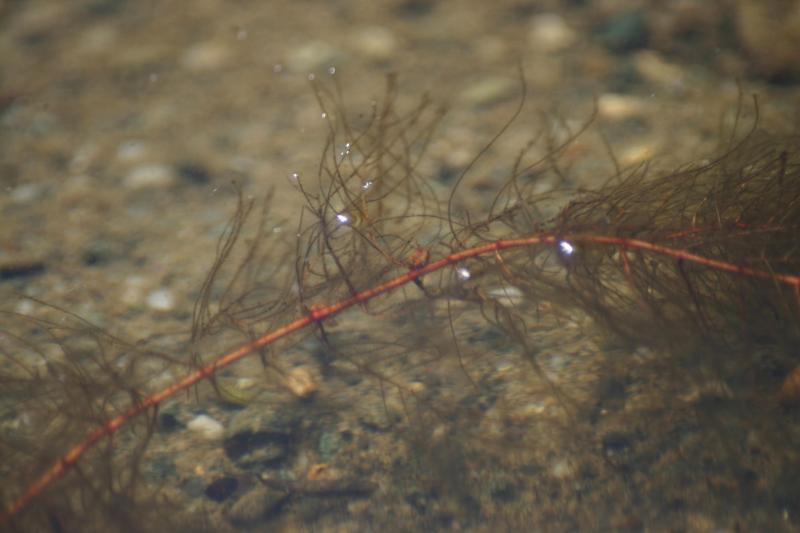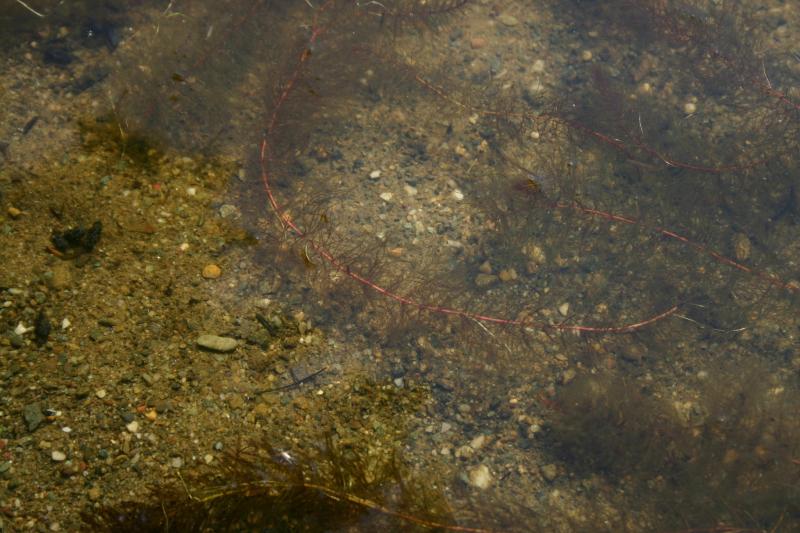Farwell's Water Milfoil
Myriophyllum farwellii Morong
- Class
- Dicotyledoneae (Dicots)
- Family
- Haloragaceae (Water-Milfoil Family)
- State Protection
- Threatened
Listed as Threatened by New York State: likely to become Endangered in the foreseeable future. For animals, taking, importation, transportation, or possession is prohibited, except under license or permit. For plants, removal or damage without the consent of the landowner is prohibited.
- Federal Protection
- Not Listed
- State Conservation Status Rank
- S2
Imperiled in New York - Very vulnerable to disappearing from New York due to rarity or other factors; typically 6 to 20 populations or locations in New York, very few individuals, very restricted range, few remaining acres (or miles of stream), and/or steep declines.
- Global Conservation Status Rank
- G5
Secure globally - Common in the world; widespread and abundant (but may be rare in some parts of its range).
Summary
Did you know?
The genus name Myriophyllum comes from the Greek, murios (myrios), "countless, infinite", and fullon (phyllon), "leaf; foliage"; hence "many leaved". The specific name farwellii, honors the American botanist Oliver Atkins Farwell (1867-1944). Small fish and aquatic invertebrates use this plant for shelter. Most populations in New York are large and contain thousands of plants.
State Ranking Justification
There are seven known populations and at least six historical populations. There are numerous Adirondack lakes that should be surveyed. The current threats are minimal and the presumed long/short-term trends are stable.
Short-term Trends
Few of New York's populations have been surveyed more than once so trends are difficult to assess. Our best guess though is these populations are relatively stable.
Long-term Trends
This plant has always been rare in New York and many historical localities have not been checked. The number of plants has probably not changed appreciably in the last 100 years. With the continued acidification of lakes, there is a chance that this plant will become more common within the state.
Conservation and Management
Threats
Motorized water craft likely have a negative impact on this plant. The spread and growth of various aquatic invasive species could also have an impact, but this has not been verified. More work is needed to determine the direct and indirect threats.
Conservation Strategies and Management Practices
Qualitative evidence suggests that motorized water craft cuts this plant into fragments and creates enough wave action to negatively impact shoreline populations. More work is needed to determine the long-term impacts of these activities and ways to minimize the impacts. Canoes and other such water craft seem to cause little to no harm.
Research Needs
Research is needed to determine population fluctuations over time.
Habitat
Habitat
An aquatic plant of acidic ponds, lakes, and shorelines. These often have gravelly, sandy, or silty bottoms (New York Natural Heritage Program 2004). Small ponds and lakes, marsh borders (Voss 1985). Acid ponds and streams (Crow and Hellquist 1983).
Associated Ecological Communities
- Acidified lake*
The aquatic community of a formerly alkaline lake that has received so much acid deposition (pH less than 4.7; sulfate and nitrate are now the dominant anions in precipitation in the Northeast) that the pH of the lake has decreased significantly.
- Artificial pool*
The aquatic community of a small pool that is constructed for recreational activities (e.g. swimming) or as a decorative element in a landscape design. The water is typically chlorinated, and flushed on a regular basis to reduce or eliminate the growth of algae, and bacteria; there is minimal development of any aquatic biota.
- Cultural eutrophic lake*
The aquatic community of a formerly eutrophic to mesotrophic lake that has received an increase in nutrients (especially phosphorus and nitrogen) from sewage effluent, agricultural runoff, and other pollutants.
- Eutrophic pond*
(guide)
The aquatic community of a small, shallow, nutrient-rich pond. The water is usually green with algae, and the bottom is mucky. Eutrophic ponds are too shallow to remain stratified throughout the summer; they are winter-stratified, monomictic ponds.
- Farm pond/artificial pond*
The aquatic community of a small pond constructed on agricultural or residential property. These ponds are often eutrophic, and may be stocked with panfish such as bluegill and yellow perch.
- Marsh headwater stream*
(guide)
The aquatic community of a small, marshy perennial brook with a very low gradient, slow flow rate, and cool to warm water that flows through a marsh, fen, or swamp where a stream system originates. These streams usually have clearly distinguished meanders (i.e., high sinuosity) and are in unconfined landscapes.
- Reservoir/artificial impoundment
The aquatic community of an artificial lake created by the impoundment of a river with a dam. Reservoirs are constructed to collect water for municipal and/or agricultural water use, to provide hydroelectric power, and to improve opportunities for recreational activities (e.g., boating, swimming), and development.
* probable association but not confirmed.
Associated Species
- Eriocaulon aquaticum (northern pipewort, northern hat-pins)
- Potamogeton confervoides (alga pondweed)
- Potamogeton epihydrus (ribbon-leaved pondweed)
- Schoenoplectus subterminalis (water bulrush)
- Utricularia purpurea (purple bladderwort)
Range
New York State Distribution
This aquatic plant is most common in the central Adirondacks, Adirondack foothills, and the Rensselaer Plateau. It is also reported from Suffolk County (possibly misidentified?) and Onondaga County.
Global Distribution
An aquatic plant from Nova Scotia and Quebec, south to New York, and west to Minnesota.
Identification Comments
General Description
This is an aquatic plant that grows entirely underwater. It has long intertwining stems with delicate feathery leaves about 1-2.5 cm long that are arranged alternately. The flowers are not in separate spikes but arise individually along the stem just above each leaf. The small hard fruits have vertical rows of small projections or thick hooks along the outside.
Identifying Characteristics
An aquatic plant with very slender, horizontally arching, branches. The fruiting stems appear beneath the surface of the water. The leaves are uniform, very delicate, crowded and alternate, 1-2.5 cm long, and with a slender capillary rachis. The 5-8 pairs of slender divisions are usually black-spiculate in their axils. The flowers are in axils of submersed leaves. The bracteoles are lanceolate and hyaline. The petals are rhombic and 1 mm long. The fruits are 2-2.5 mm long and the flat-sided mericarps having dorsal rows of tubercles and thick hooks.
Best Life Stage for Proper Identification
Leafy stems with mature fruit are needed for proper identification.
Similar Species
Positive identification for most water milfoil species (Myriophyllum spp.) requires fruit. When sterile, Myriophyllum farwellii is nearly impossible to separate from Myriophyllum heterophyllum unless turions are present. The fruits of Myriophyllum heterophyllum appear on very distinct stalks that stick above water, while Myriophyllum farwellii fruits appear on non-distinct submersed stems. Vegetative plants of Myriophyllum humile and Myriophyllum alterniflorum may also resemble Myriophyllum farwellii.
Best Time to See
Fruits are present from late July to early October. This is also when surveys should be conducted.
- Flowering
- Fruiting
The time of year you would expect to find Farwell's Water Milfoil flowering and fruiting in New York.
Farwell's Water Milfoil Images
Taxonomy
Farwell's Water Milfoil
Myriophyllum farwellii Morong
- Kingdom Plantae
- Phylum Anthophyta
- Class Dicotyledoneae
(Dicots)
- Order Haloragales
- Family Haloragaceae (Water-Milfoil Family)
- Order Haloragales
- Class Dicotyledoneae
(Dicots)
- Phylum Anthophyta
Additional Common Names
- Farwell's Milfoil
Additional Resources
Best Identification Reference
Crow, Garrett E. and C. Barre Hellquist. 2000. Aquatic and Wetland Plants of Northeastern North America: A revised and enlarged edition of Norman C. Fassett's a Manual of Aquatic Plants. Volume One: Pteridophytes, Gymnosperms, and Angiosperms: Dicotyledons. The University of Wisconsin Press. Madison, Wisconsin. 536 Pages.
Other References
Borman, Susan, Robert Korth and Jo Temte. 1997. Through the Looking Glass. A Field Guide to Aquatic Plants. Wisconsin Lakes Partnership, University of Wisconsin - Stevens Point, Stevens Point, Wisconsin.
Ceska, A. and P.D. Warrington. 1976. Myriophyllum farwellii (Haloragaceae) in British Columbia. Rhodora 78:75-77.
Crow, G.E. and C.B. Hellquist 1983. Aquatic Vascular Plants of New England: Part 6. Trapaceae, Haloragaceae, Hippuridaceae. New Hampshire Agricultural Experiment Station. University of New Hampshire. Station Bull. 524.
Fernald, M.L. 1950. Gray's manual of botany. 8th edition. D. Van Nostrand, New York. 1632 pp.
Gleason, Henry A. and A. Cronquist. 1991. Manual of Vascular Plants of Northeastern United States and Adjacent Canada. The New York Botanical Garden, Bronx, New York. 910 pp.
Holmgren, Noel. 1998. The Illustrated Companion to Gleason and Cronquist's Manual. Illustrations of the Vascular Plants of Northeastern United States and Adjacent Canada. The New York Botanical Garden, Bronx, New York.
Mitchell, Richard S. and Gordon C. Tucker. 1997. Revised Checklist of New York State Plants. Contributions to a Flora of New York State. Checklist IV. Bulletin No. 490. New York State Museum. Albany, NY. 400 pp.
Morong, T. 1891. Myriophyllum farwellii, nov. sp. Bull. Torr.Bot. Club 18:146-147.
New York Natural Heritage Program. 2010. Biotics database. New York Natural Heritage Program. New York State Department of Environmental Conservation. Albany, NY.
New York Natural Heritage Program. 2024. New York Natural Heritage Program Databases. Albany, NY.
Reschke, Carol. 1990. Ecological communities of New York State. New York Natural Heritage Program, New York State Department of Environmental Conservation. Latham, NY. 96 pp. plus xi.
Voss, E.G. 1985. Michigan Flora. Part II. Dicots (Saururaceae - Cornaceae). Cranbrook Institute of Science and University of Michigan Herbarium. Ann Arbor, Michigan. 724 pp.
Weldy, T. and D. Werier. 2010. New York flora atlas. [S.M. Landry, K.N. Campbell, and L.D. Mabe (original application development), Florida Center for Community Design and Research http://www.fccdr.usf.edu/. University of South Florida http://www.usf.edu/]. New York Flora Association http://newyork.plantatlas.usf.edu/, Albany, New York
Links
About This Guide
Information for this guide was last updated on: December 22, 2004
Please cite this page as:
New York Natural Heritage Program. 2024.
Online Conservation Guide for
Myriophyllum farwellii.
Available from: https://guides.nynhp.org/farwells-water-milfoil/.
Accessed July 27, 2024.

